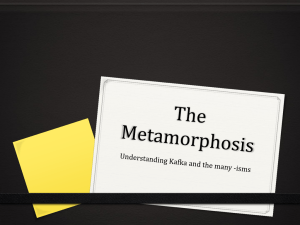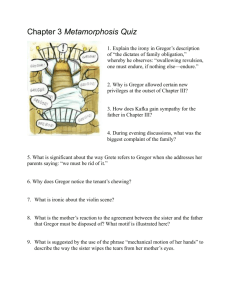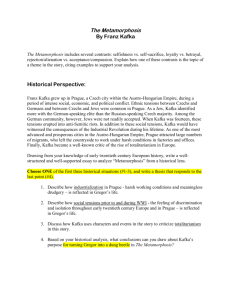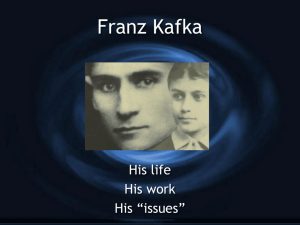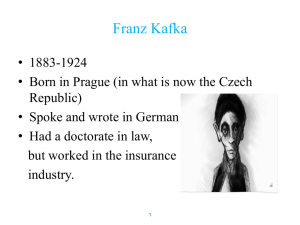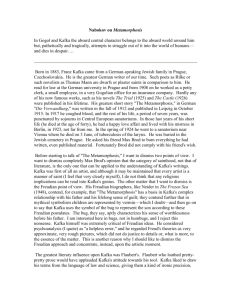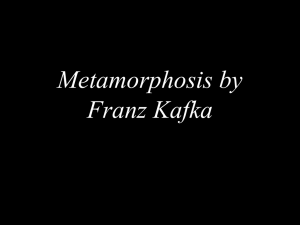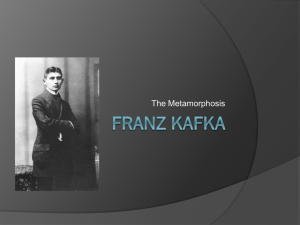Final Essay - WordPress.com
advertisement
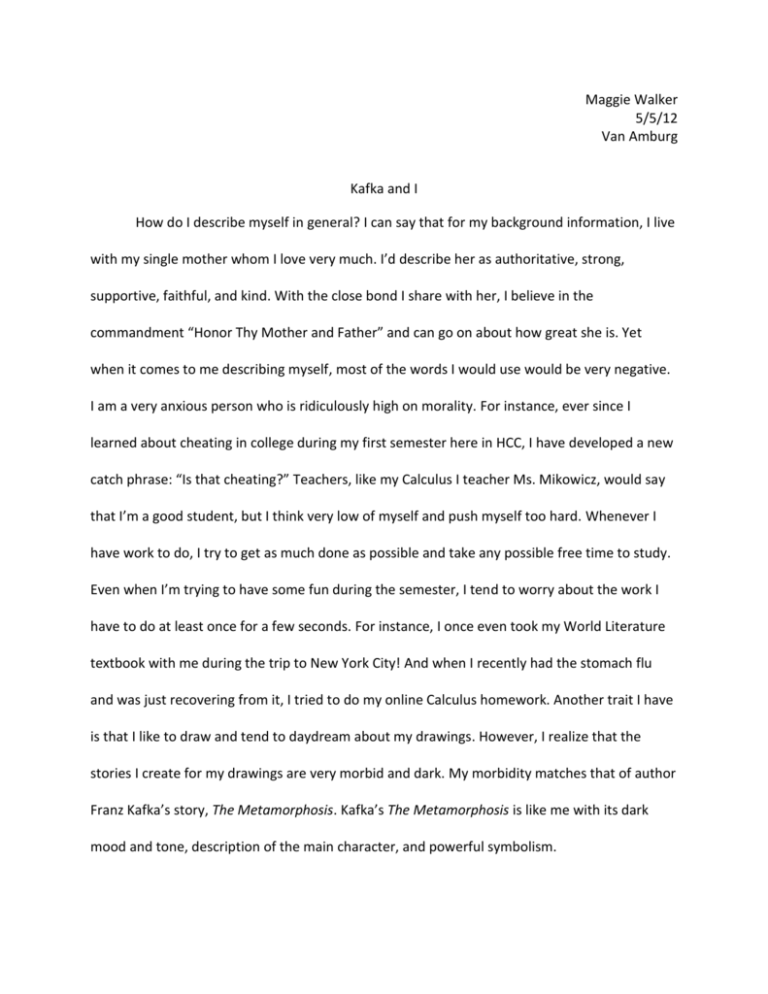
Maggie Walker 5/5/12 Van Amburg Kafka and I How do I describe myself in general? I can say that for my background information, I live with my single mother whom I love very much. I’d describe her as authoritative, strong, supportive, faithful, and kind. With the close bond I share with her, I believe in the commandment “Honor Thy Mother and Father” and can go on about how great she is. Yet when it comes to me describing myself, most of the words I would use would be very negative. I am a very anxious person who is ridiculously high on morality. For instance, ever since I learned about cheating in college during my first semester here in HCC, I have developed a new catch phrase: “Is that cheating?” Teachers, like my Calculus I teacher Ms. Mikowicz, would say that I’m a good student, but I think very low of myself and push myself too hard. Whenever I have work to do, I try to get as much done as possible and take any possible free time to study. Even when I’m trying to have some fun during the semester, I tend to worry about the work I have to do at least once for a few seconds. For instance, I once even took my World Literature textbook with me during the trip to New York City! And when I recently had the stomach flu and was just recovering from it, I tried to do my online Calculus homework. Another trait I have is that I like to draw and tend to daydream about my drawings. However, I realize that the stories I create for my drawings are very morbid and dark. My morbidity matches that of author Franz Kafka’s story, The Metamorphosis. Kafka’s The Metamorphosis is like me with its dark mood and tone, description of the main character, and powerful symbolism. The overall mood of the story, like many of Kafka’s other stories, is dark and sad. For instance, the story immediately starts with the main character, Gregor Samsa, waking up to find himself transformed into a cockroach (Kafka 945). The story then describes the lengthy struggle of Gregor merely trying to get out of bed. The first two parts always end with Gregor’s father, Mr. Samsa, hurting him. When Gregor’s family, along with Gregor’s boss, first see him in his cockroach form, Mr. Samsa grabs the boss’ cane and a rolled up newspaper and tries to chase Gregor back into his room. Part one ends as thus: “when from behind, his father now gave him a truly liberating kick, and he was thrown, bleeding profusely, far into the room. The door was battered shut with the cane, and then at last there was quiet” (Kafka 956). In the end of part two, Mr. Samsa catches Gregor out of his room and throws a barrage of apples at him. One of them pierces Gregor in the back and he begins to black out from the wound (Kafka 966-967). Nobody takes the apple out of his back, so it remains their throughout the story, causing the wound to become infected. But what makes the story even darker is as the story progresses, Gregor’s family lose their sympathy for him and eventually speak about trying to get rid of him while he was in the room with them, thinking that he can’t understand them (Kafka 974). When Gregor does die, his family and the maid’s reaction was, “’Ah,’ said Mr. Samsa, ‘now we can give thanks to God.’ He crossed himself, and the three women followed his example” (Kafka 976). The story ends with the Samsas going on about their lives and Gregor is never mentioned again. The sad fate of Gregor and the cruel growing indifference his family gives him makes The Metamorphosis a truly morbid tale. Who is Gregor Samsa besides a man who transformed into a cockroach? He is the protagonist of the story and is a static character. For instance, Mr. Samsa describes Gregor as a workaholic and a very stubborn man. He says, “It almost worries me that he never goes out on his evenings off” (Kafka 950). His workaholic behavior and stubborn behavior can still be seen after his transformation when he tries to get ready for work despite his situation (Kafka 948) and when he refused to let his sister, Grete, and his mother, Ms. Samsa, take away the framed picture that hung on his bedroom wall. “Well, just let her try!” Kafka describes Gregor’s determination, “He would perch on his picture, and never surrender it” (965). Despite some of the tensions he experiences with his family, he tries to remain loyal and kind to them, especially to his sister. For instance, when he was aware that his sister was hesitant about coming into his room and seeing him in his current state, Gregor decided to hide under the sofa whenever she came in to feed him or clean his room (Kafka 957). He finds it frustrating that he can’t thank her. “Had Gregor been able to speak to his sister and to thank her for everything she had to do for him, he would have found it a little easier to submit to her ministrations” (Kafka 961). Finally, when he overhears his family wishing to get rid of him after he accidently startles them and the visiting tenants, he feels ashamed for frightening them and returns to his room to leave them alone (Kafka 974). What makes Kafka’s The Metamorphosis so intriguing is the extent of symbolism used throughout the story. One example is Gregor and his cockroach form. Gregor must represent Franz Kafka himself. Throughout the years, since man has become aware of them, cockroaches are considered as filthy vermin that are better off dead. Gregor’s form slowly causes him to fall into that disgraceful category where he is no longer referred to as a “he”, but an “it.” Kafka was described as “a tormented and sensitive soul, guiltily resentful of his job in a giant bureaucracy, unable to free himself from his family or to cope with the demands of love, physically feeble, and constantly beset by the feelings of inferiority and doom in an existence whose laws he can never quite understand” (944). He considered himself such a failure that he even asked to have three unfinished novels to be burned (944). Therefore, the cockroach form represents Kafka’s self-loathing and low self-esteem. Another symbol seen in The Metamorphosis occurs when Gregor is upside down and struggling to get out of bed. The description of Gregor’s struggle is almost too frustrating and painful to imagine. Kafka describes Gregor’s numerous legs and how they just flail about randomly when Gregor tries to get them to hoist him off the bed (948). He also describes how Gregor had to rock himself off the bed, only to bump his head on the floor when he manages to get off (949). This painlful display of imagery explains how helpless and vulnerable an upside down cockroach can be. This may symbolize Kafka’s helplessness during his personal struggles. The final symbol is Gregor’s father, Mr. Samsa. Mr. Samsa represents authority in general and Kafka’s father, who was described as “a domineering, self-made man” (944). Mr. Samsa displayed his authority through actions by beating Gregor back into his room. But the most impressive display was his change of appearance. When Gregor saw his father the second time since his transformation, he noticed that he was no longer the feeble, slow-moving man that he knew. Mr. Samsa was wearing a blue uniform decorated with gold buttons and his hair was tidy. His father also had “an alert and vigorous expression in his black eyes” to match his attire (Kafka 966). Mr. Samsa’s violent actions and military attire is the very physical embodiment of sheer authority. The mood, character development, and symbolism of The Metamorphosis seem to reflect Kafka himself, as well as it reflects me. Our self-loathing views represent the image of the verminous cockroach, or in modern cases, the stinkbug. If I had to say one thing in The Metamorphosis that does not represent me is the family’s shunning of Gregor. My family loves me very much and they don’t pressure m to do well, yet I am afraid of letting them down. Works Cited “Franz Kafka 1883-1924.” The Norton Anthology. Ed. Sarah Lawall. New York: W.W. Norton & Company, 2009. 943-945. Kafka, Franz. “The Metamorphosis.” The Norton Anthology. New York: W.W. Norton & Company, 2009. 945-977.
